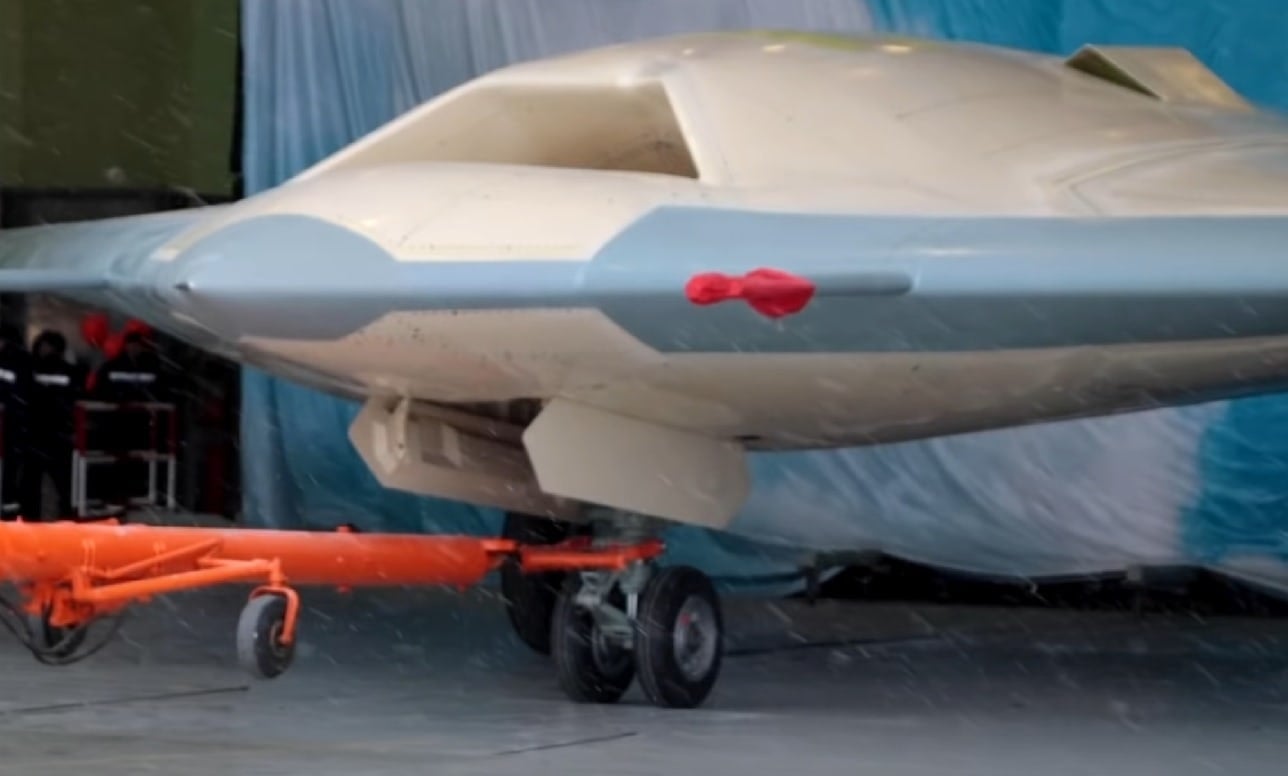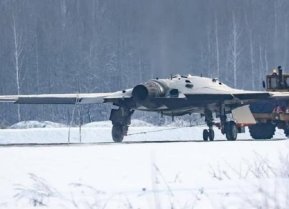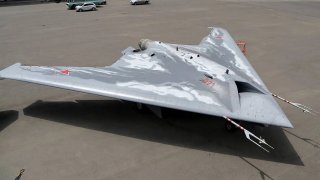Sukhoi S-70 Okhotnik-B: Russia's Stealth Drone Lie or Deadly Reality?
One Russian UAV that may soon complete its development phase is the Sukhoi S-70 Okhotnik-B. Often referred to as “Hunter-B,” this stealth-heavy unmanned combat aerial vehicle is being produced alongside Moscow’s sixth-generation aircraft project by manufacturers Sukhoi and the Russian Aircraft Corporation MiG.
Meet the S-70: Russia’s ongoing invasion of Ukraine has been largely described as a drone war. Since February 2022, both Moscow and Kyiv have deployed a variety of unmanned aerial vehicles in combat. These cheap, easily operated, and acquired aerial weapons have become synonymous with the invasion. Both Russian and Ukrainian troops possess combinations of domestic and foreign-designed drones. The Islamic Republic of Iran has notably delivered scores of combat UAVs to aid Moscow’s offensive efforts while the U.S. and its North Atlantic Treaty Organization (NATO) allies have supplied alternatives to Kyiv. Recently, more and more countries are beginning to view increasing drone popularity as an avenue to drive up domestic manufacturing. Iran and Russia are even coordinating the development of a UAV factory outside of Moscow. While the Kremlin will continue to lean on its rogue ally Tehran to support its war efforts against Ukraine, it is simultaneously building up its homegrown drone capabilities.
Introducing the S-70
One Russian UAV that may soon complete its development phase is the Sukhoi S-70 Okhotnik-B. Often referred to as “Hunter-B,” this stealth-heavy unmanned combat aerial vehicle is being produced alongside Moscow’s sixth-generation aircraft project by manufacturers Sukhoi and the Russian Aircraft Corporation MiG.
The drone was initially conceptualized more than a decade ago, when the Russian Defense Ministry awarded Sukhoi the contract to create a new lethal UCAV program. Moscow refers to the S-70 as a “sixth-generation platform,” touting that
it is capable of penetrating outer space.
Specs and Capabilities
By 2014, the first mock-up of the UCAV was created. Within a few years, the drone prototype was publicly revealed, showing the weapon’s flying wing configuration. By 2018, the S-70 carried out its first series of testing, where it reportedly reached a speed of 200 km/h.
Following the outbreak of the COVID-19 pandemic, Sukhoi continued to make progress on the UCAV. In 2021, the weapon dropped an unguided bomb. In 2021, the S-70 allegedly used 500kg unguided bombs to destroy a ground target.
Although Russia claims that this “stealth” aerial weapon is top-of-the-line, some experts doubt its purported capabilities. Moscow has a history of exaggerating and even making up military-related claims.
How the S-70 Will Fly Alongside the Su-57
The S-70 is designed to fly alongside Russia’s Su-57 fighter jet in a “wingman” role. While details surrounding the exact specs of the UCAV remain unclear, the drone is believed to be powered by the same AL-41F turbofan that Russia’s Su-35 Flanker fighter is equipped with.
This engine has 32,000 pounds of thrust that produces a top speed of 620 miles per hour. Moscow first designed the Su-57 to counter the aerial threat posed by America’s fifth-generation fighters- the F-22 Raptor and F-35 Lightening II.
Andrey Yelchaninov, the first deputy chairman of the Board of the Russian Military-Industrial Commission, has asserted that “These planes and drones can interact not only with each other but also in various types of combat formations,” adding that “Within a very short timeframe, there will be a possibility to control several Okhotnik drones from the Su-57 cockpit.”
Will the S-70 Be Deployed Anytime Soon?
Russian defense contractor Rostec also examined the artificial intelligence data link that enables the Loyal Wingman capability between the S-70 and Su-57 fighter: “AI-based technology enables noise-immune coding through the use of parallel channels. This is the ‘wrap’ of the technology. Its structure includes multiple interleaving of symbols, time synchronization during transfer, simultaneous transmission of data in all directions [air-to-ground or air-to-air], and increasing the range of transmitted data.”

Over the summer, a video circulated widely on social media allegedly displaying an S-70 flying alongside a MiG-29 (NATO reporting name Fulcrum) fighter jet in Ukraine.
However, the location and date of the video have yet to be confirmed. Russia has publicly claimed that its new UCAV would enter service by 2024. Considering Moscow’s resource shortage though, this timeline may not line up with reality. Russia has specifically struggled to procure computer chips and other advanced components to sustain its military equipment being used in its ongoing Ukraine invasion.
These materials shortages coupled with sanctions do not put Russia in the position to produce new pieces of equipment quickly. Additionally, some experts have indicated that the advanced artificial intelligence necessary to produce a UCAV as sophisticated as the S-70 may not even be possible for Moscow to produce domestically.
Since Russia’s defense and aerospace industry typically relies on foreign parts and components, the imminent deployment of the S-70 UCAV is probably not a real possibility anytime soon. Regardless, Moscow’s moves to enhance its domestic drone-making capabilities should raise alarm bells.
Maya Carlin is an analyst with the Center for Security Policy and a former Anna Sobol Levy Fellow at IDC Herzliya in Israel. She has by-lines in many publications, including The National Interest, Jerusalem Post, and Times of Israel. You can follow her on Twitter: @MayaCarlin.
All images are screenshots from Russian state media.


